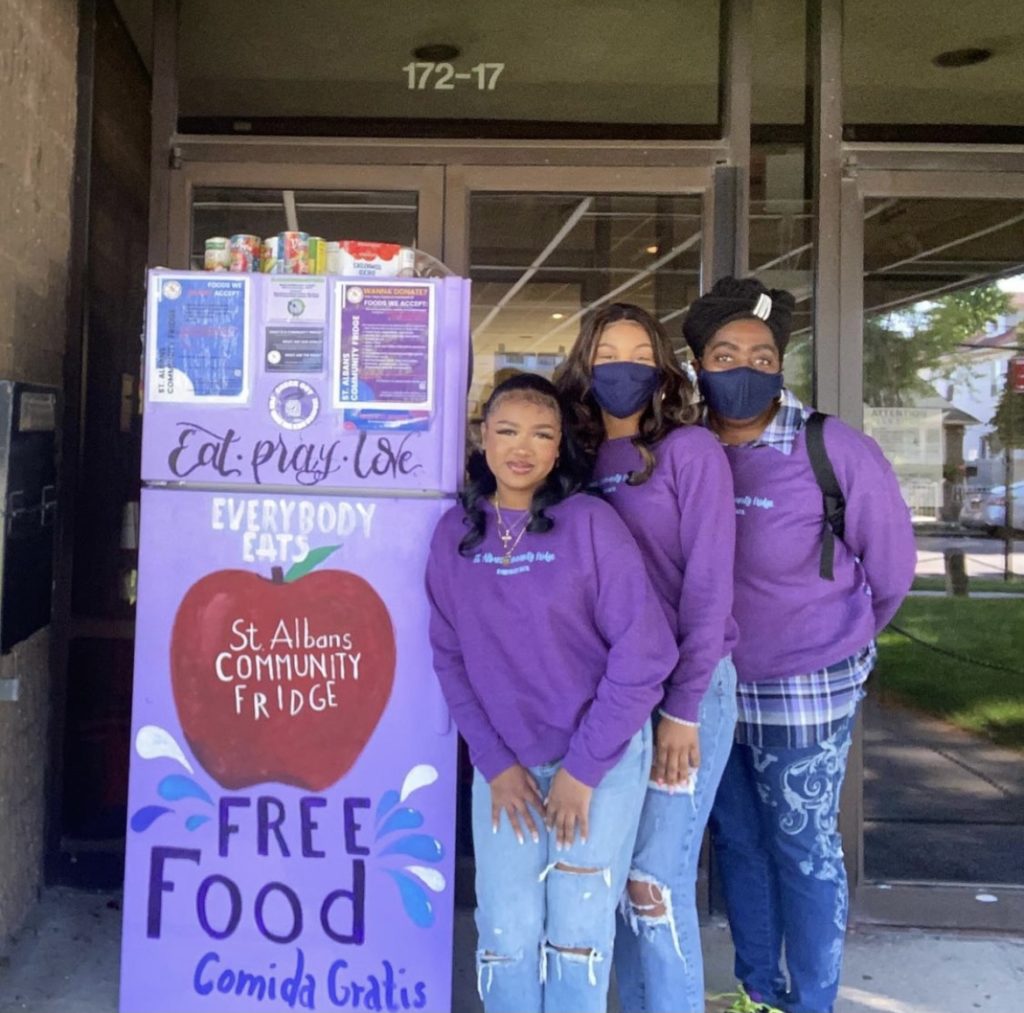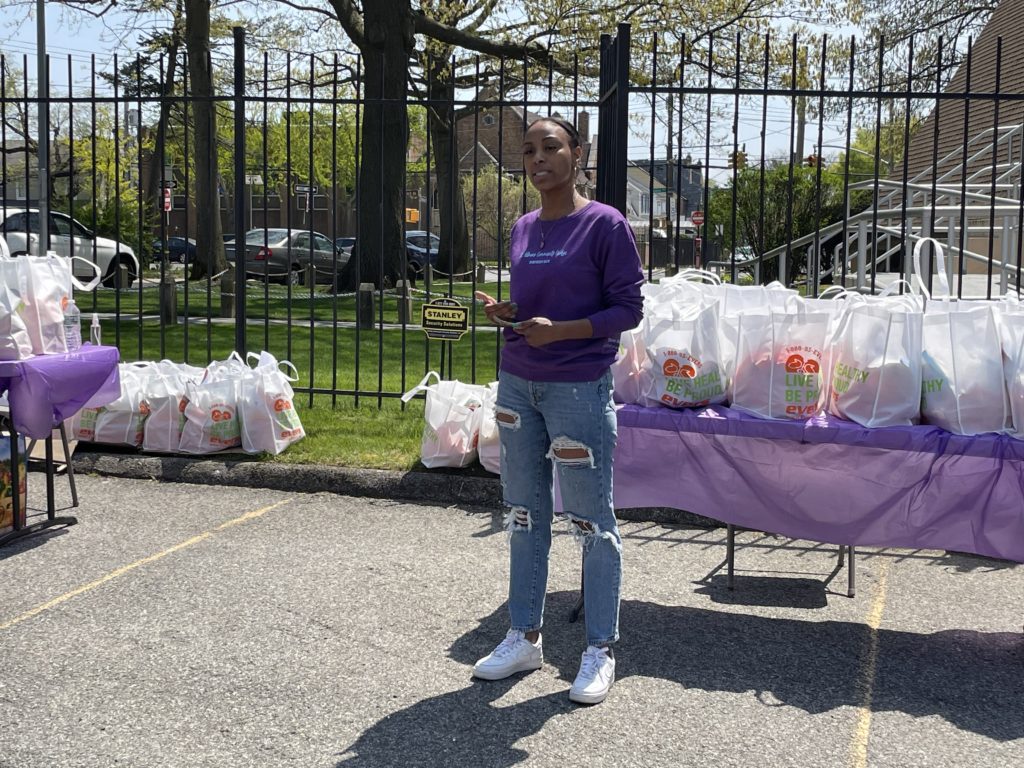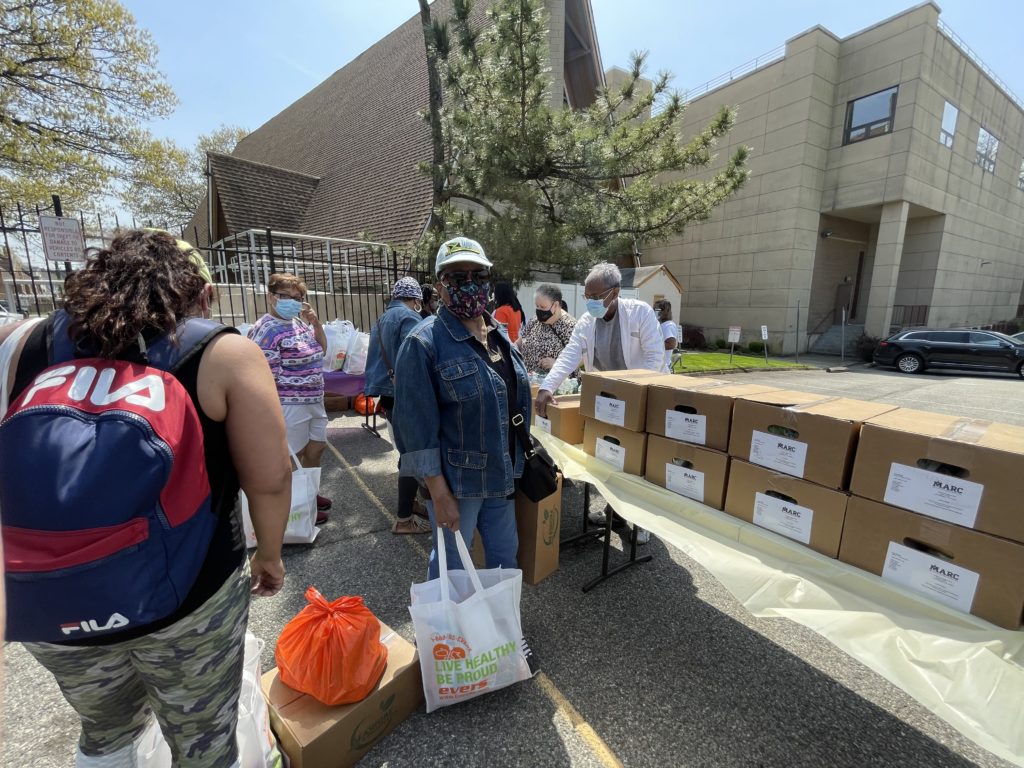
First Community Fridge Opens in St. Albans
By Kiara Thomas
Dozens of Queens residents and community leaders gathered at the parking lot of the Robert Ross Johnson Family Life Center in St. Albans on April 24 to celebrate the opening of its first community fridge.
Rows of 135 cloth bags and 146 cardboard boxes filled with lentils, cabbage, apples, non-perishables and other fruits and vegetables, free of charge, were placed on tables lining the parking lot gate. More than 20 organizations and individuals donated, cosponsored and volunteered for the event.
“David Bradley said, ‘There are no good times to be Black in America, but some times are worse than others and we’ve all seen and felt some worst times being Black or Brown during this pandemic,” Tiffany Eason, the 28-year-old organizer of the St. Albans community fridge, said. “This community fridge is a short-term solution to a long-term problem.”
Eason’s nonprofit, All Things Work, Inc., promotes sustainable development and social justice in communities of color. Her work is inspired by the Black Panther Party’s Ten-Point Program, Black nationalist leader Marcus Garvey, the late influential rapper Tupac Shakur, and the United Nations Sustainable Development Goals (SDGs). Eason, a proud member of Zeta Phi Beta Sorority, Inc., decided to put a community fridge in her childhood neighborhood, St. Albans, where she lived with her mother and four siblings.

“A lot of people around here are hungry,” Eason’s mother and Queens public school teacher, said. “Go open the refrigerator and get something to eat. Don’t be embarrassed. Don’t be afraid. No child should be starving. No adult should be starving.”
The St. Albans community fridge, donated by the Queens Care Collective and painted by Eason and Britney Dixon, is one of more than 70 community fridges in New York City and 160 across the United States. The goal of the grassroots initiative is to achieve food security, improve the nutrition systems, support local agriculture and gardens, and encourage responsible production and consumption of nutritious foods. The fridge provides anyone and everyone with fresh healthy food 24 hours a day, no questions asked.
The three rules for the St. Albans fridge are: to take what you need, leave what you don’t, and properly discard and recycle food scraps. All of the leftover food from the fridge that is inedible and is able to be composted will be delivered to the Garden of Resilience in Springfield Gardens and the NYC Sanitation Compost Project bins hosted at the Queens Botanical Garden.
“I want to see our community grow,” Dixon, the public relations and community chair of the St. Albans community fridge, said. “We’ve been stagnant for a lot of years and I’ve worked for elected officials and there are times where you don’t see improvement. Even though you don’t see [it], you have to be the improvement yourself. You have to be out there on the streets, doing what you have to do in order to make your community better.”
St. Albans is one of the five neighborhoods that make up the Greater Jamaica area. The middle-class Black and Caribbean community was home to many Black prominent figures, including James Brown, Lena Horne, W.E.B. Du Bois, and Shirley Graham, who resided in Addisleigh Park, an affluent, historic district within the neighborhood. Many residents say that while they are middle-class on paper, their socioeconomic status isn’t reflected in their lifestyle. The COVID-19 pandemic made it nearly impossible for families who were already scrapping the little money they had to provide for their families.

“I’m glad to see it in St. Alban’s because one thing, a lot of people have the misconception of is that everybody’s doing great in St. Albans – that everybody has a lot of money, whether it’s Laurelton, St. Albans, or any other part of Southeast Queens. People think everybody there is doing great,” Manny Silva, former Queens City Council candidate, said. “There’s a thing called being house poor. There’s a thing where all of your income is going into your bills and your housing, and then you don’t qualify for any of the public assistance. And you have to choose between paying a credit card bill or feeding your family.”
One in five Jamaica residents receive the Supplemental Nutrition Assistance Program (SNAP). “The use of Supplemental Nutrition Assistance Program (SNAP) benefits, or food stamps, is an indicator of food insecurity; the majority of households that receive SNAP are food insecure,” according to the NYC Foodscapes report. The same report found that Jamaica residents have higher rates of nutrition-related chronic diseases, including childhood obesity and adults who are obese and diagnosed with high blood pressure and diabetes, when compared to New York City overall.
“There’s been a lot of challenges in our communities and food insecurity is ranked very high across the entire borough,” Queens Borough President Donovan Richard said. “I’m very thankful when we get volunteers setting up a community fridge for our community. This is what it should be about. We have to take care of each other. The government is not going to resolve all of our issues simply, but if we all do one good duty a day think about the difference that makes in our community.”
Throughout the six-month process leading to the debut of the St. Albans community fridge, Eason contacted local community leaders for their opinion and guidance. An undisclosed official who disapproved of the fridge told her that homeowners in the “very, very conservative neighborhood” didn’t want to see a community fridge because it may bring down the value of the area. The comment “shocked” Eason.
“I don’t tell people what I’m going to do,” Eason said. “I ask ‘what do you need?’ and I try and meet that need and I try and find a solution. That’s really the reason why I wanted to do the community fridge because it’s not just for me, it’s for all of us to benefit.”

